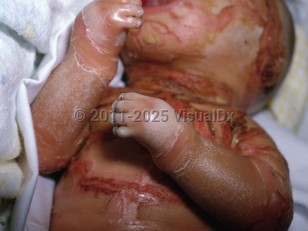Harlequin ichthyosis
Alerts and Notices
Important News & Links
Synopsis

Harlequin fetus, or harlequin ichthyosis, is a general term used to describe neonates born with severe, characteristic cutaneous findings. The underlying pathogenesis is attributable to the spectrum of ichthyosis disease that is thought to be inherited in an autosomal recessive manner, supported by reports of consanguinity. Mutations in ABCA12 have recently been detected in several patients. ABCA12 functions in lipid transport to the keratinocyte via lamellar granules; a loss of function results in compromise of the skin lipid layer.
In general, infants are encased in thick, hyperkeratotic scale that restricts movement. Shortly after birth, the hyperkeratotic cast cracks, leaving large adherent plates with deep fissures present throughout the body. Ears are typically misshapen or absent, with similar disfigurement of the nose, fingers, and toes. Infants will also have pronounced eclabium and ectropion. Eyebrows and eyelashes are usually absent.
Affected infants are typically born prematurely and die within several weeks, after succumbing to respiratory insufficiency, hypothermia, sepsis, hypernatremic dehydration, or complications of prematurity. Advanced neonatal intensive care, aggressive topical management, and use of oral retinoids have resulted in the survival of several patients beyond the postnatal period. Survivors may develop severe exfoliative erythroderma. Long-term multidisciplinary care is required for management of these patients.
In general, infants are encased in thick, hyperkeratotic scale that restricts movement. Shortly after birth, the hyperkeratotic cast cracks, leaving large adherent plates with deep fissures present throughout the body. Ears are typically misshapen or absent, with similar disfigurement of the nose, fingers, and toes. Infants will also have pronounced eclabium and ectropion. Eyebrows and eyelashes are usually absent.
Affected infants are typically born prematurely and die within several weeks, after succumbing to respiratory insufficiency, hypothermia, sepsis, hypernatremic dehydration, or complications of prematurity. Advanced neonatal intensive care, aggressive topical management, and use of oral retinoids have resulted in the survival of several patients beyond the postnatal period. Survivors may develop severe exfoliative erythroderma. Long-term multidisciplinary care is required for management of these patients.
Codes
ICD10CM:
Q80.4 – Harlequin fetus
SNOMEDCT:
268245001 – Harlequin fetus
Q80.4 – Harlequin fetus
SNOMEDCT:
268245001 – Harlequin fetus
Look For
Subscription Required
Diagnostic Pearls
Subscription Required
Differential Diagnosis & Pitfalls

To perform a comparison, select diagnoses from the classic differential
Subscription Required
Best Tests
Subscription Required
Management Pearls
Subscription Required
Therapy
Subscription Required
References
Subscription Required
Last Updated:01/17/2022

